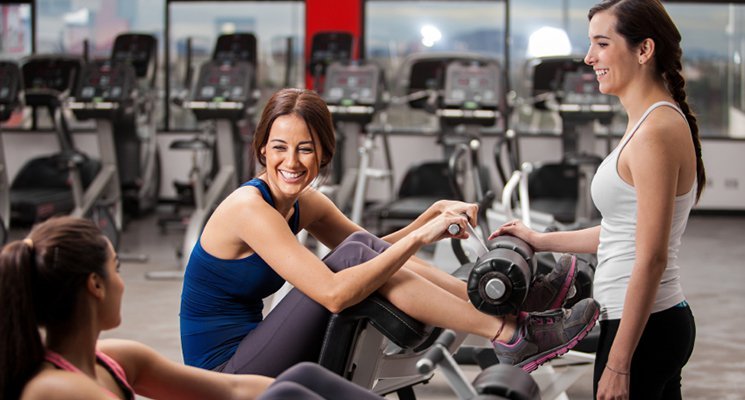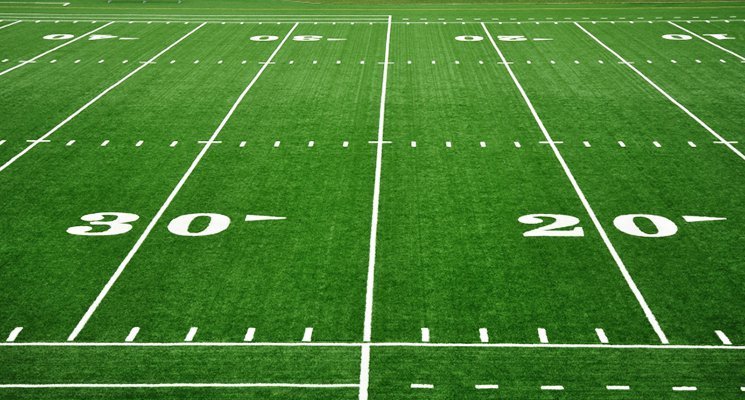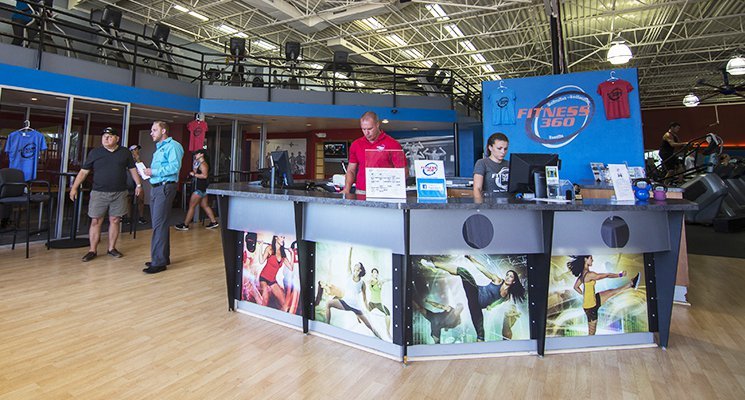A new indoor ice center slated to open in the Bronx, New York, in 2017 will generate more than $1.7 billion in economic benefits to the surrounding community, according to a study recently released by the center’s developer. If built according to plans, the 750,000-square-foot facility, known as the Kingsbridge National Ice Center, will become the largest of its kind, hosting nine indoor ice rinks and a giant community center.
The facility will occupy an existing building, the Kingsbridge Armory, which has stood vacant since 1996. Desiree Pilgrim-Hunter, spokesperson for the Kingsbridge Armory Redevelopment Alliance, called the ice center “a game changer” for the neighborhood. She said, “We’re on the cusp of creating a new economy for the Northwest Bronx.” “We’ve seen new athletic facilities completely transform the communities in which they’re established,” said Chris Fernandez, Customer Success Specialist, of EZFacility, a sports facility management software developer in Woodbury, New York. “Jobs, tourism, sports teams, fans, nearby restaurants and hotels — all of these things follow in the wake of new sports facilities, and they can have a huge positive impact on the local area.”
When plans for the ice center were drawn up, the Kingsbridge Armory Redevelopment Alliance signed an agreement requiring at least 51 percent of employees to be Bronx residents, and stipulating that employees be paid at least $10 per hour with benefits or $11.50 without. In addition, the community will receive 1.5 percent of the ice center’s annual revenues, or $276 million over the 99-year lease period. Also, the residents of the surrounding area will have free access to the 50,000-square-foot community center that will occupy the rink.
Author: ezfacility

Encouraging Exercise Partnerships
Thomas Acquinas said, “Friendship is the source of the greatest pleasures, and without friends even the most agreeable pursuits become tedious.” The corollary, of course, is that with friends even the most disagreeable pursuits become less tedious. As far as exercising goes, whether one sees it as an agreeable pursuit or a disagreeable pursuit, one thing has been made adequately clear through both rigorous research and personal anecdote: Doing it with a friend makes it more effective.
Studies have shown, for example, that we lose weight better when we work out with a partner. At Miriam Hospital/Brown Medical School and the University of Massachusetts Dartmouth, for example, researchers found that participants in a weight loss regimen that included exercise lost more weight when their support partners took part in the same program and were successful at dropping pounds. Others who participated alone, or whose workout partners did not lose weight, did not lose as much weight themselves.
It turns out that even just spending time with fitter friends helps. In the book Friendfluence, journalist Carlin Flora writes, “We seek out health and weight-loss advice, but the most effective plan might be to hang out with fit friends. Not only do they make it easier for us to eat better and work out by setting an example and dragging us along on active outings, but they also provide the human connection that fosters robust physiological characteristics, such as lower blood pressure and increased immunity.”
And, perhaps even more surprisingly, we don’t even need real-time interaction with friends to make exercise more effective; even just being part of an online group can help people achieve their workout goals better. For example, a Northwestern University study published in the Journal of the Royal Society Interface found that people who actively engage in online weight-loss communities lose a higher percentage of their body weight compared with users who participate less. In the study, the most active participants, who recorded their weight and engaged with other members of an online forum that grants access to weight-loss tools, lost more than 8 percent of their body weight in a six-month period. The least active users, who had the fewest online friends and social interactions, lost only about 5 percent of their body weight in the same time span.
The question you should be asking yourself is clear: How can your facility capitalize on friendship? The more you can encourage your members and prospective members to come in and work out with friends, the more you’ll be leading folks to success in their exercise goals, and the better your retention numbers will be. It’s as simple as that. So, consider offering special “friendship deals” — classes half off for members and their friends, if they bring them. Or launch membership drives during which anyone who becomes a member by a certain date wins a month’s free membership for a friend? Or start a weekly “Friend Day” initiative: Members bring a friend to the gym for free on that day. Make sure that your club management software handles guest passes as well as robust reporting on membership data. Also, consider whether you can build an online community for members to offer each other support. There are endless variations on these possibilities, and the potential benefits for your facility are huge — as are the potential benefits for your members and their friends.
World’s Largest Ice Facility to Open in the Bronx
A new indoor ice center slated to open in the Bronx, New York, in 2017 will generate more than $1.7 billion in economic benefits to the surrounding community, according to a study recently released by the center’s developer. If built according to plans, the 750,000-square-foot facility, known as the Kingsbridge National Ice Center, will become the largest of its kind, hosting nine indoor ice rinks and a giant community center.
The facility will occupy an existing building, the Kingsbridge Armory, which has stood vacant since 1996. Desiree Pilgrim-Hunter, spokesperson for the Kingsbridge Armory Redevelopment Alliance, called the ice center “a game changer” for the neighborhood. She said, “We’re on the cusp of creating a new economy for the Northwest Bronx.”
“We’ve seen new athletic facilities completely transform the communities in which they’re established,” said Danielle Comeau of EZFacility, a sports facility management software developer in Woodbury, New York. “Jobs, tourism, sports teams, fans, nearby restaurants and hotels — all of these things follow in the wake of new sports facilities, and they can have a huge positive impact on the local area.”
When plans for the ice center were drawn up, the Kingsbridge Armory Redevelopment Alliance signed an agreement requiring at least 51 percent of employees to be Bronx residents, and stipulating that employees be paid at least $10 per hour with benefits or $11.50 without. In addition, the community will receive 1.5 percent of the ice center’s annual revenues, or $276 million over the 99-year lease period. Also, the residents of the surrounding area will have free access to the 50,000-square-foot community center that will occupy the rink.

Creating Opportunities for Better Mental Health
Philadelphia’s Drexel University recently installed a mental health kiosk in the lobby of its recreation center. Part of a pilot program initiated by the nonprofit organization Screening for Mental Health, Inc. and the Philadelphia Department of Behavioral Health & Intellectual Disability Services, the kiosk enables users to conduct quick, anonymous self-assessments to gauge their risk for mental health issues, such as anxiety, depression, substance abuse, and eating disorders, and provides information about the next step to take if treatment seems warranted.
Gyms, health clubs, exercise boutiques, and sports centres could take a cue from Drexel. After all, creating opportunities for fitness is about more than just encouraging people to keep their bodies in great shape. And retaining members requires efforts above and beyond simply providing the equipment to help them meet their weight-loss or fitness goals. It’s also necessary to promote overall wellness, so that your members leave your facility recognizing the degree to which it enriches their lives. If the physical part of the wellness equation is taken care of but the mental part is ignored, then they won’t feel they’ve achieved true fitness.
So maybe it’s time to consider how your facility could help members and clients work on their mental health alongside their physical health. Installing a kiosk like Drexel’s is one way to go. When your members come in for a workout, they could stop by the kiosk and take a self-assessment to determine whether their mental wellbeing is at risk. If so, depending on their results, they could get specific guidance regarding helpful steps to take for prevention or healing. Another option might be hiring a full- or part-time psychotherapist or licensed social worker. It might sound strange, but if you conceive of your facility as one with a mission to provide a holistic approach to health and wellbeing, it makes good sense. After or before a workout, or after performing a self-assessment at the mental health kiosk, members could sit down with the onsite therapist to discuss what’s troubling them.
Can your facility accommodate a pet room? If so, consider taking on board a therapy dog; this, in fact, is another approach that Drexel has undertaken. Drawing on studies that have shown that playing with a therapy dog can reduce blood pressure and lower anxiety and depression, the university’s recreation center hosts its own therapy dog (Jersey), who is available for sessions to help students cope with stress.
Other possibilities: Invite speakers knowledgeable on mental-health topics to address an audience made up of your members (and prospectives) and answer questions they might have. Hold a mental health fair, inviting local agencies, mental health providers, and meditation experts to come set up booths where your clientele can explore options for mental health upkeep. Increase your yoga, meditation, and other mind-body offerings, explicitly pitching them to members as initiatives designed to help them identify and/or address mental health issues.
For several years now, as gyms, sports centres, and other fitness facilities have expanded their offerings and redefined the concept of the health club, colleges and universities have been similarly expanding the role of their campus recreation centres. The campus rec center model, with its focus on providing educational programming and activities that aim to introduce lifelong habits for a healthy lifestyle, might be a good one for the fitness industry to adapt. The better our members and clients feel, and the more attention we pay to their overall health, the more likely they are to retain their memberships. And that’s ultimately what we want: for them to feel good enough that they keep coming back and keep coming back.

Your Mission: To Think About Mission Statements
Recently, a post on IHRSA’s blog gave me pause. It features Fred Hoffman, owner of Fitness Resources in France, and it focuses on the relationship between personal trainers and member retention. What struck me is that Hoffman talked only a little about that relationship; what he emphasized is the importance of mission statements. As he put it, “Policies, procedures, performance standards—all should be based on [a] company’s mission statement and represent its core values.”
This got me thinking. Really, what is a mission statement? Hoffman argues that “whatever takes place in a club is a reflection of the company and its management.” In this conception, a mission statement is like a mirror you hold up to your club to make sure that it looks the way you want it to look. If you glance into the mirror and what you see doesn’t match your ideas about what you should see, then you know it’s time to make changes. If you don’t have the mission statement—don’t have the mirror—then you have nothing against which to compare your reality, nothing by which to judge how close your reality is to meeting your ideal. How then do you know what to change? How do you assess the “whatever takes place in your club” to ensure that it is a true reflection of your company and its management?
So, as Hoffman says, “If you have a mission statement, revisit it, and, if you don’t, draft and fine-tune one.” Your mission statement should do several things:
• Provide an explanation of what your club does
• Include a description of your corporate culture
• Incorporate examples to show how your corporate culture manifests itself
• Enumerate your club’s core values
• Explain how the core values are used to obtain desired results for members, staff, suppliers, and the business as a whole
Thus, it’s not enough to state your goals. As they say in the journalism business, “specific is terrific”: You need to explicitly state what you are, what you do, what activities and attitudes define you. You need to provide concrete examples, avoiding abstract language that ultimately doesn’t mean much. And you need to pull it all together to show how you accomplish everything that you want to accomplish.
How then do you use the mission statement, in practical terms? During your hiring process, share it with potential employees. Make sure that they understand it. If it doesn’t make sense to them, or if they can’t see how it forms the basis for everything the club does and every decision management makes, they might not be the right employees. If they do understand it, make sure they see how the role they would play within the club aligns with it. To use the personal-trainer-and-retention example, if one of the core values your mission statement outlines is member retention, make very clear how the responsibilities set forth in the job description relate to member retention. Show how each core value jibes with the various job responsibilities described.
Finally, make sure employees never forget the mission statement. There’s a reason why grade school children used to have to recite the Pledge of Allegiance every morning. You don’t have to make your employees recite the mission statement daily, but do post it prominently in a staff lounge. Do bring it up during staff meetings. Do discuss it with employees when you meet with them one on one. If your employees see how important the mission statement is to you, they’ll believe how important it is to them.

Behind the Curtains—Mike Vidal
Welcome to the first edition of EZFacility’s Behind the Curtains series! Today’s guest (or victim) is Michael Vidal, Product Owner and self-proclaimed family man. Mike is here to give us the inside scoop on EZFacility’s development team, the product development process at a growing company and how to juggle the needs of customers, prospective customers and the team players at EZFacility.
Read the full interview here

Keeping Your Facility Germ-Free—and Your Members Happy
In 2008, IHRSA published the Guide to Health Cleanliness, which highlighted the startling results of a survey: More than 90 percent of survey participants said they were more apt to renew their membership with a health club facility if the facility was clean. That might not be so surprising, but here’s the shocking part: Only slightly more than half said they would renew if the facility was not clean.
Keep in mind that this was six years ago, before the Ebola scare, before enterovirus D68, before super-strong strains of the flu were floating around. With these threats around us, and with media hype that frequently blows such threats out of proportion, it’s little wonder that health club and sports facility users are even more cautious than they used to be. Add to that the fact that we’re smack in the middle of cold season, and you’ve got potentially a lot of skittish members on your hands who want assurance that their health is protected when they’re using your facility.
What can you do to reassure them? First of all, make sure you’ve got a plan for keeping your place as clean as possible. Review your cleanliness policies and procedures. Are they up to date? Do they follow best practices? Are they generally in keeping with standards set by the Centres for Disease Controls (for example, wash hands with soap and water for 20 seconds or rub an alcohol-based sanitizer on hands for 15 seconds before and after workouts; shower after workouts; avoid walking barefoot across exercise floors and locker rooms)?
After you’ve polished up your policies, start thinking about your staff. Do they know the policies? Do they know what to do if they’re sick (best practices say they should stay home)? Do they know what tasks they should take responsibility for in order to help maintain the highest standard of cleanliness possible? Organize a mandatory staff meeting solely around these issues and make sure everyone is on board. Do frequent walkthroughs with a cleanliness checklist to make sure rules are being adhered to.
Finally, communicate directly and explicitly with your members about cleanliness in your facility. Send out an email explaining your concerns during the season, highlighting the steps your club is taking to stay as germ-free as possible, and asking members to remain aware of ways in which they can help contribute to a cleaner club environment. List specific tips, like the Centres for Disease Control standards shown above. A post on IHRSA’s blog describes an email Newtown Athletic Club recently sent to its members. Linda Mitchell, Newtown Athletic’s director of PR and Marketing, devised a letter with the subject line “Healthy Facilities Initiative.” She and her team carefully worded the letter, avoiding making any promises but being sure to explain procedures. They assured members that maintaining a clean facility is a top priority. Then they described new procedures being implemented and outlined member responsibilities. Mitchell told IHRSA that the email had an unheard-of 35 percent open rate—to her a clear indication that members were hungry for information about facility cleanliness.
Ultimately, you want to make your members feel secure, and you want them to know you welcome their questions and can answer them satisfactorily. Over and above that, you want to keep your facility as germ-free as possible — for your members’ sake, but also for your own and your staff’s. Provide a safe environment, clearly communicate the details about how you’ve done so, and keep everyone feeling strong and healthy all winter long.

Transform Your Space—And Maybe Even Your Identity
So, you own an ice arena and you worry about lost revenue in the summer. Or, you run an indoor soccer facility and you can’t justify having all soccer, all the time. Or, sometimes you just wish your basketball court had turf. Well, put your mind at ease, because it can. According to an article in Athletic Business magazine, there’s been a recent boom in portable synthetic turf, and new, updated models have hit the market just in the past six months. As the article puts it, “The turf is temporary by design, boasting an ability to be rolled up, removed and later reapplied, or…stacked and stored for future reconnection.”
Portable and temporary turf—it’s a game changer. Manufacturers like AstroTurf, FieldTurf, Ecore, and others report to Athletic Business that demand for the product has exploded. The business director at one such company, Sporturf, said, “It’s one of the fastest-growing segments of our business… The upfront cost to purchase this turf is minimal compared to the cost of [a] facility just sitting there empty.”
Many different kinds of facilities are employing the product these days, from Houston’s Reliant Stadium—which removes natural grass on which the pro teams play to lay down synthetic turf for high school games—to independent personal training spaces, where, facility owners might want some weight-room flooring on one side and some turf on the other. The Edward Jones Dome in St. Louis, Lucas Oil Stadium in Indianapolis, the Milwaukee Wave’s Major Arena Football League—all these are big-time facilities that regularly use temporary turf to change their floor surface depending on the changing needs of various players.
Interested in portable turf for your own facility but not sure where to begin? Keep in mind that the product comes in two basic forms: rolls and panels. Rolls can vary in width, with some of them measuring 15 feet wide and 200 feet long—great for creating an instant football field. The gigantic ones can be massive enough to require heavy machinery during installation and removal (but even with the cost of machinery factored in, the product saves money in the long run). Panels tend to range in size from seven and a half square feet to 32 square feet, depending on the manufacturer. These can be installed and uninstalled relatively easily, with just a couple of employees—or players—handling even the largest ones. Some temporary turf is held in place with heavy-duty Velcro. Other versions fit together with peg-in-hole fasteners or puzzle-like interlocking edges.
On the whole, manufacturers see portable turf as a way for smaller venues to maximise programming. Consider how such a product might help you maximise your own programming. With a temporary turf surface, could you hold drills for sports teams you’ve never before imagined hosting? Could you keep your facility running for an entire season during which you usually shut your doors? Could you expand your offerings and thereby revolutionize your entire brand identity? With a product that has the power to transform both your physical space and your customers’ ideas about you, it’s worth considering exactly how you might make use of it.

Rethinking Reception Areas—in Real Life & Online
We all know the cliché: First impressions matter. Some social scientists have suggested that we size up new people, places, and things within thirty seconds of first encountering them, making decisions about them then and there. Of course, first impressions often are proven wrong — but sometimes, depending on the content of a given impression or the person forming it, there’s no chance to prove it wrong. Fact is, clichés are clichés for a reason: They tend to touch on some kind of truth. In the fitness and sports facility industries in particular, first impressions really do matter. Potential members might decide in a split second whether to sign up with your facility or not.
What gives someone a first impression of your organization? Your reception area, of course. Or, I should say, your reception areas, because in this day and age you likely have two: a virtual one and a bricks-and-mortar one. If you want to sell memberships effectively, you have to consider both carefully.
Let’s think first about the old-fashioned one, the bricks-and-mortar reception area. Remember, this space represents a transition from the outside world — that is, the world that contains a potential member’s stressors, responsibilities, and aggravations — to your facility. How do you want people who walk through your doors to experience that transition? Chances are, you want them intuitively and immediately to grasp that they’re entering a sanctuary, a safe harbor that will hold the stressors, responsibilities, and aggravations at bay. The more they feel that, the more likely they are to keep coming back. In other words, you want your reception area, that first-impression space, to do the work of fulfilling what are likely two of your facility’s main goals: signing up new members and retaining existing ones.
How do you accomplish this? First, ask yourself how warm, welcoming, and calming your reception area is. Is it a carefully designed space, with colours, lighting, fixtures, and signage that let people know you want them there, you’re friendly, and they can relax? Maybe you have a fountain, plants, yellow lighting angled just so. At the same time, is the space energizing enough to help people get into a workout mindset — a splash of bright colour on one wall, say, an image that suggests intensity and power? Does it look generic, as if a person standing there could be anywhere, or does it look like it could be only one place in the world: your facility, reflecting your identity? Do your front desk employees smile? Do they know members by name? (Of course, needless to say, the space should be uncluttered and impeccably clean.)
If you answered no to any of these questions, it’s probably time for an overhaul. An architect or interior designer can help you get started. One step you can take right away is researching current design trends for fitness and sports facility reception areas — and then being sure to avoid them. Part of the first impression you want to aim to create is the sense that your place is different, in a category all its own.
Now, what about your virtual reception area, a.k.a. your website homepage? In the old days, of course, this wasn’t something a gym owner or manager had to worry about. But the fact is that nowadays, people form an impression of your facility before ever stepping foot into it, and they do that by looking you up online. Take a good, hard look at your homepage ask yourself some questions. Some of the questions are similar to the ones you want to ask about your physical space: Is it warm? Is it welcoming? Does it set you apart from other facilities? But you also want to consider the following: Does the page load quickly? Does it avoid being overly busy? Does it reflect and reinforce your facility’s brand identity? Does it efficiently answer questions people are likely to ask, or provide obvious links to answers?
A final key point to keep in mind: Online impressions are formed not only through your facility’s webpage, but also via reviews on Google, Yelp, personal blogs, and other such pages. If you’re concerned about potentially negative impressions these kinds of sites might leave, or if you just have no idea how to begin approaching the issue, consider hiring an online reputation expert, someone who combs through existing pages about your business and strategizes ways to emphasize the good stuff.

Encouraging Proper Hydration
Last weekend, my nine-year-old asked me to pack three bottles of water for his soccer match: one he could drink before the game and at half-time, one that I’d stuck in the freezer that he wanted to let partially melt so he could have it cold after the game, and one he could dump over his head when he felt too hot. When we got home, to my astonishment, I found all three bottles empty.
It was a good reminder for me. Athletes — whether they’re kids, varsity level, or pro players — get thirsty. The same goes for everyday exercisers. There’s a lot in the news about preventing and treating concussions, teaching gym members treadmill safety, setting swimming pool limits to prevent overexertion, and the like, but you don’t hear enough about the risks of dehydration. The fact is, fitness facilities, sports centres, coaches, trainers, and health club managers have as much of a responsibility to keep their members, clients, and players educated about hydration as they do to protect them from muscle or head injury.
So how do you do that? First, realize that many exercisers and athletes do not know that it’s dangerous to wait until thirst kicks in to take a drink. Studies have shown that most people underestimate their water needs; one researcher found that 98 percent of the members of one college football team started out daily workouts underhydrated. It’s important, then, to begin by reminding clients to drink water frequently. If you run a gym or other kind of fitness facility, have your instructors or personal trainers make periodic announcements reminding folks to take a swig. At sports centres, mandate frequent water breaks. In all facilities, put up posters that highlight the National Athletic Trainers’ Association’s rule of thumb: Drink 7 to 10 ounces — about one cup or a little more — of water or a sports drink every 10 to 20 minutes during a workout. And consider installing a water cooler next to the exit with cute signs that draw attention to it.
Of course, social media is a great way to get the message across too. Start a hydration awareness campaign on Twitter, posting a daily tweet with facts about how much water the body needs. Put up relevant videos and photos on Facebook so anyone visiting your page will see that you’re serious about hydration. Another possibility: Consider partnering up with a bottled-water company for innovative ways to spread the word. Perhaps the bottled-water supplier would agree to giving away free bottles to your members and clients one day, or to co-hosting a hydration awareness day fair at your facility.
The more creative you are about getting the message across, the more effective your message will be. And your campaign will benefit your facility as much as it does your customers: It’ll give you a new platform for getting your name out there; it will establish your facility as a caring, community-minded one; it could help lessen your liability if an unfortunate event involving dehydration occurs; and it will give you chance to help improve the lives of exercisers and athletes everywhere.
Now please excuse me while I go fill up a dozen bottles to stick in my refrigerator and freezer for my son’s next match this coming weekend.